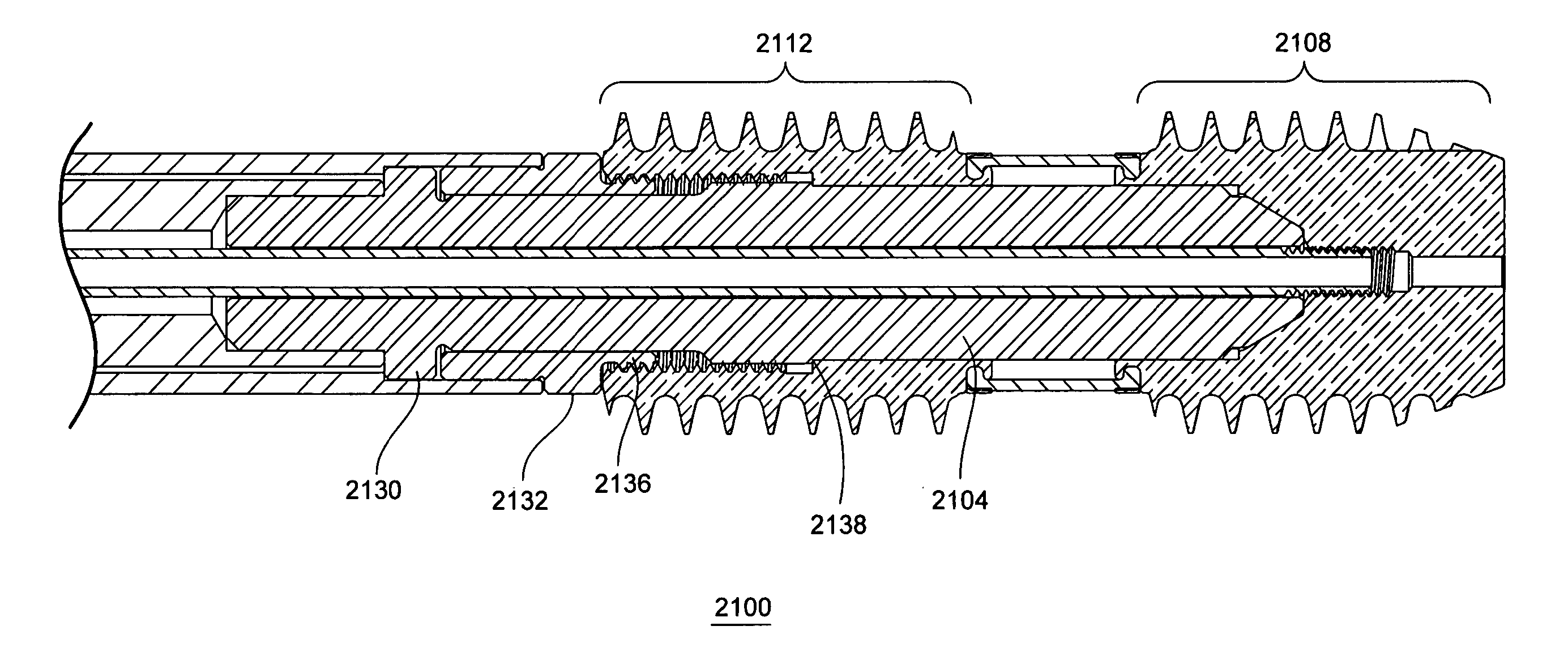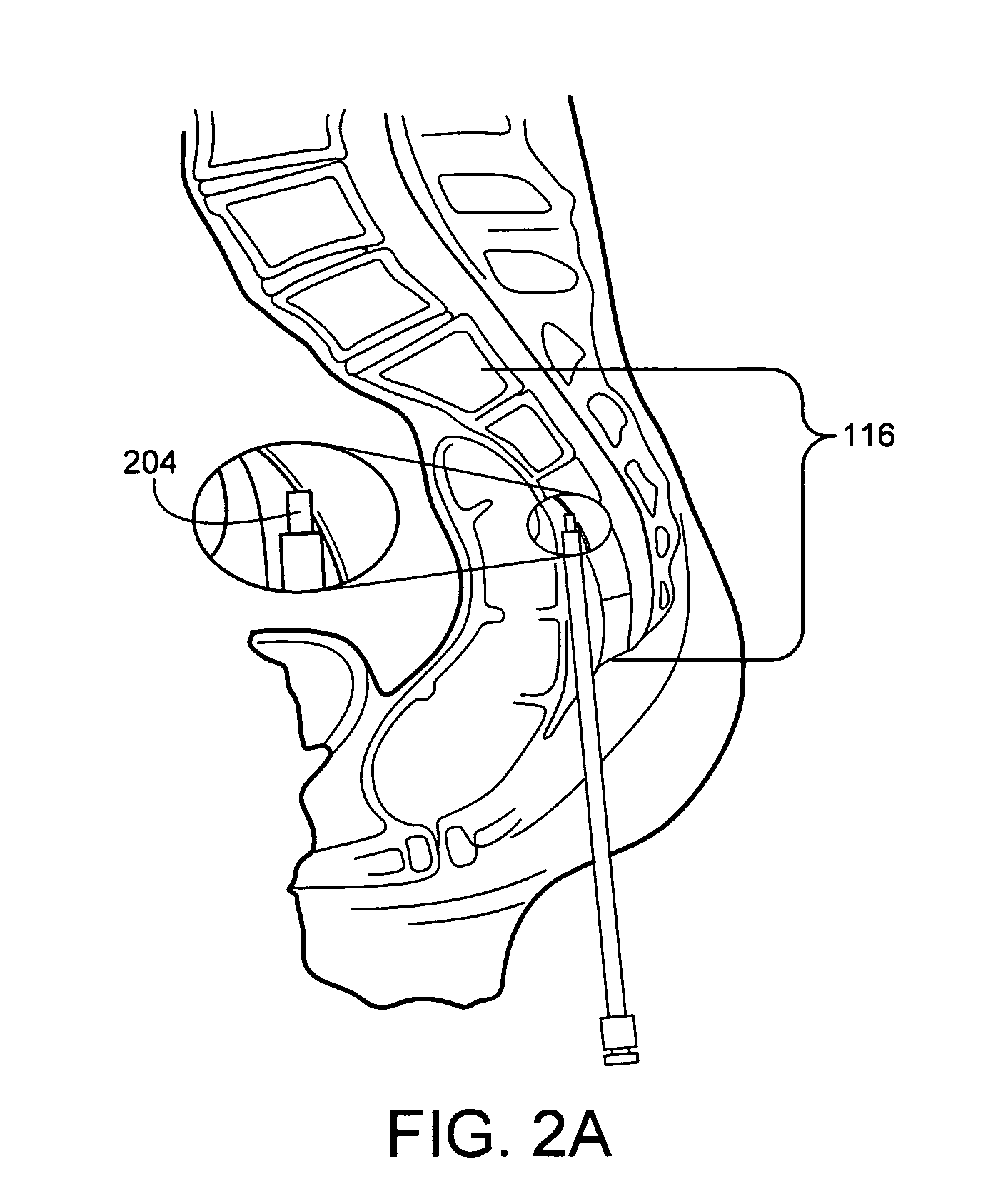Driver assembly for simultaneous axial delivery of spinal implants
a technology of spinal implants and drive shafts, which is applied in the direction of prosthesis, osteosynthesis devices, catheters, etc., can solve the problems of reduced gap between adjacent vertebrae, increased weight of spinal discs, and increased pain, so as to improve weight bearing and load distribution
- Summary
- Abstract
- Description
- Claims
- Application Information
AI Technical Summary
Benefits of technology
Problems solved by technology
Method used
Image
Examples
example a
[0081] One solution to the above-identified short comings in the prior art is shown in FIG. 6. FIG. 6A shows an enlarged portion of a loaded dual anchor driver assembly 2100 in a perspective view with a quarter round removed to expose the interaction of components. The dual anchor driver assembly 2100 uses a polygonal torque driver 2104 to simultaneously engage a distal bone anchor 2108 and a proximal bone anchor 2112. These bone anchors have external threaded sections (2116 and 2120) that have the same minor diameter, the same major diameter, the same pitch, and the same handedness. In order to avoid cross threading the helical thread cut left by distal anchor external threads 2116 in the proximal vertebral body as the proximal anchor external threads 2120 are rotated into the proximal vertebral body, the delivery of the two bone anchors must be timed. Having control over the relative position of the bone anchors during the rotation and axial advancement of the bone anchors makes t...
example b
[0087] As shown in FIG. 10, polygonal torque driver 2104 has a hollow cavity 2224 running along its longitudinal axis which is used by the retention rod 2012. This same cavity 2224 could be connected through apertures (not shown) to deliver flowable material between the distal component 2108 and the proximal component 2112 into the intervertebral disc space. A variety of biomaterials can be delivered. Examples include curable elastomers, hydrogels, and blends of elastomers and hydrogels. While the cavity 364 in the distal end of the distal component is open to allow a loaded driver assembly to be deployed over a guide wire, this should not present a problem while injecting material. The opening to the cavity 364 will often be contained within the distal vertebral body (See FIG. 3). However, the retention rod or some other delivery device could be used to deliver a plug to this cavity 364 after it has served its purpose with respect to the guide wire.
example c
[0088]FIG. 17 shows an alternative torque driver 2230 with apertures 2234. A dual hex head driver 2230 of this type is adapted for use when the cross section of the distal component is reduced relative to the cross section of the proximal component such as illustrated in FIG. 5B, typically when dissimilar thread pitch is being used to provide distraction. After distraction, a driver assembly using the dual hex head driver 2230 can be left in place, that is with the driver maintaining the relative position of the two components as one component is held by engagement with the distal portion of the dual hex head driver 2230 by the retention rod and the other component is held in engagement with a more proximal portion of the dual hex head driver by the coupling. FIG. 18A provides an exploded diagram showing the use of an O-Ring to help limit the undesired flow of injected material into the driver assembly. FIGS. 18B and 18C illustrate other details of the interaction between the dual h...
PUM
| Property | Measurement | Unit |
|---|---|---|
| Length | aaaaa | aaaaa |
| Flow rate | aaaaa | aaaaa |
| Distance | aaaaa | aaaaa |
Abstract
Description
Claims
Application Information
 Login to View More
Login to View More - R&D
- Intellectual Property
- Life Sciences
- Materials
- Tech Scout
- Unparalleled Data Quality
- Higher Quality Content
- 60% Fewer Hallucinations
Browse by: Latest US Patents, China's latest patents, Technical Efficacy Thesaurus, Application Domain, Technology Topic, Popular Technical Reports.
© 2025 PatSnap. All rights reserved.Legal|Privacy policy|Modern Slavery Act Transparency Statement|Sitemap|About US| Contact US: help@patsnap.com



